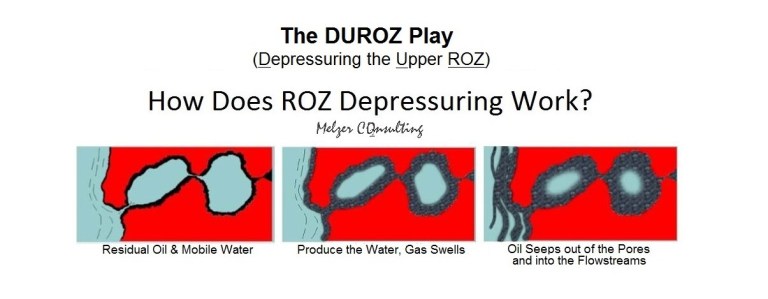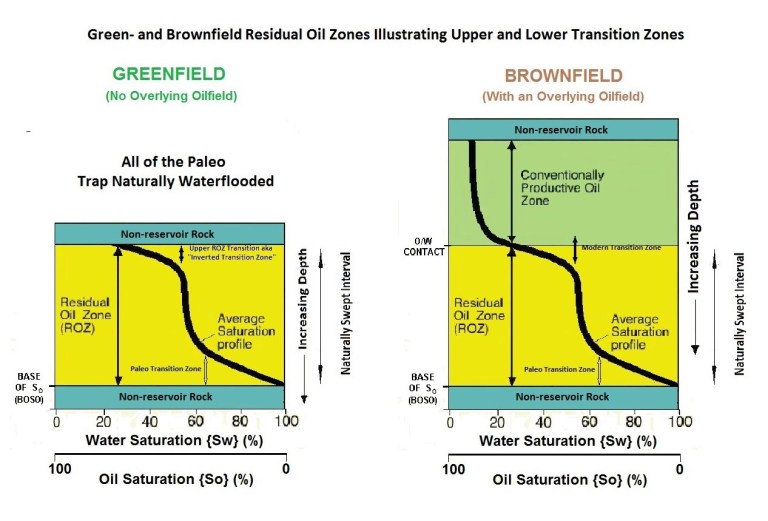
In the course of historical oil field development, the so-called Producing Oil/Water Contact (POWC) formed the base level of drilling. When water production became dominant, the best approach was to terminate drilling at the POWC. Recent work in the Permian Basin has shown that commercial recovery of oil can be found well beneath the POWC in what we have come to refer to as Residual Oil Zones (ROZs). These ROZs can be ubiquitous and quite thick. In particular, the Wasson, Seminole fields and the Tall Cotton project area have as much as 350 feet in the interval with OOIP numbers easily rivaling the main pay zone. The ROZs can exist where no primary oil production occurs in what we have come to know as “greenfields.” Where an overlying field exists we have called the ROZs “brownfields” and there, the wells can be deepened to extend into the ROZ.
The first type oil recovery concept can be most simply described as using CO2 injection, as in a pattern-type CO2 flood, to recover oil from zones that may possess water saturations as high as 75% of the pore space. The concept is analogous to CO2flooding water swept intervals in the main pay where water saturations have risen to 50-75% due to the waterflood.
Historically, the zones were attributed to capillary and surface tensional forces and were called transition zones. The extraordinarily thick zones seen in the Permian Basin’s San Andres formation necessitated an alternative explanation. For discussion of the types and origins of the ROZs see the original 2006 ROZ report entitled: Stranded Oil in the Residual Oil Zone.

The foundational studies on the origins of Residual Oil Zones was conducted in the Permian Basin in 2006. The report was sponsored by the United States Department of Energy. Click here to download the report.
Since that early report, two methods of exploiting the residual oil have occurred. The latest is what is commonly referred to as reservoir depressuring and the other is enhanced oil recovery (EOR). As horizontal depressuring and EOR projects are deployed to reservoirs without an overlying main pay zone (greenfields) or below the producing oil/water contact (brownfields), some interesting observations began to develop. It was recognized that the reservoirs in the Permian Basin’s San Andres formation dolomites were (1) more pervasively dolomitized, more so than the Main Pay Zones (MPZs), (2) have a very live oil in the upper 100 feet of the ROZ, (3) have better porosity and permeability showing nominally faster processing times than the MPZs, and (4) appear to have decaying lighter end components in the oil with depth. The research suggested that the latter observation is either due to the original density stratification within the paleo trap or is induced from effects of the laterally swept (Type III ROZ) paleo waterflood.
The CO2 EOR industry is still trying to better forecast why certain projects witness injectivity losses after Water – Alternating – Gas (WAG) cycles, while some do not. We are beginning to see a correlation of greater injectivity losses with greater oil wetting which appears to be more common in the ROZs. ROZ flooding is still immature and some are worried that the long proven WAG approaches and strategies for the MPZs are not going to work as well in the maturing ROZ floods. But oil production is excellent and time will tell on the longer term recoveries.
A ROZ Research Group has been formed under a local, Midland Texas based, non-profit organization, the Applied Petroleum Technology Academy (www.aptapb.org), and liaisons have been developed to further understand the above observations and other research questions. The Enhanced Oil Recovery Institute of the University of Wyoming http://www.uwyo.edu/eori (medium gravity oils in ROZs and wettability), University of North Dakota’s Energy and Environmental Research Center http://www.undeerc.org (CO2 dense phase behavior and lab testing), The University of Texas of the Permian Basin http://ceed.utpb.edu (mapping of ROZ spatial distributions and log analyses), Advanced Resources International http://www.adv-res.com (computation modeling).
Residual Oil Zones do not just appear below main pay zones; some of the largest lie in areas beyond where no MPZs are present. Mapping of the ROZ fairways of occurrence in the Permian Basin was started in 2012 and the first phase is reported in a recently completed mapping project (see residualoilzones.com). sponsored by the Research Partnership to Secure Energy for America.
Melzer Consulting is very actively involved in researching the residual oil zones (ROZs) both in the Permian Basin and elsewhere. In the original ROZ report U.S. Department of Energy report, Steve Melzer documented the three types of ROZs which are being found as folks study reservoirs throughout the world. Type 3 (laterally flushed) ROZs (Type 3 video below) is a common type and the ones currently being commercially exploited (all within the San Andres formation in the Permian Basin). However, the other two types shown in the videos (Type 1 video below; Type 2 video below) are also common. Work is continuing on documenting the origins and worldwide occurrence of the ROZs as well as CO2 flood response as in the Permian Basin Tall Cotton project and the Goldsmith field in Ector County, Tx.
